
Senna hebecarpa, with the common names American senna and wild senna, is a species of legume native to eastern North America.

Heteranthera limosa is an annual flowering plant in the water hyacinth family known by the common names ducksalad and blue mudplantain. It grows in shallow water or on mud. It is considered a threatened species in parts of the central United States, and an invasive species weed in California, where it is a nuisance in rice paddies. It is also occasional in Florida waterways.

Viburnum nudum is a deciduous shrub in the genus Viburnum within the muskroot family, Adoxaceae.
Puccinellia pumila is a species of grass known by the common names dwarf akaligrass and smooth alkali grass. It is native to North America where it grows along the coastline in the northern latitudes, from Alaska across Arctic northern Canada to Greenland. It occurs on the coast of the Pacific Northwest in the United States and it is known from the Kamchatka Peninsula. The grass is only found on the coast, in wetland habitat, beaches, and areas inundated by the highest tides, in saline sand and mud. This perennial grass grows decumbent or erect to a maximum height near 40 centimeters, often remaining much smaller, especially in harsh habitat. It may root at stem nodes which become buried in wet substrate. The inflorescence is a dense or open array of branches bearing spikelets.

Lythrum alatum, commonly known as winged loosestrife, winged lythrum or angled purple-loosestrife, is a species of flowering plant belonging to the family Lythraceae. It is endemic to wetland areas in central and eastern United States and Ontario.

Liatris novae-angliae, commonly known as the New England blazing-star, is a species of flowering plant in the aster family, Asteraceae.
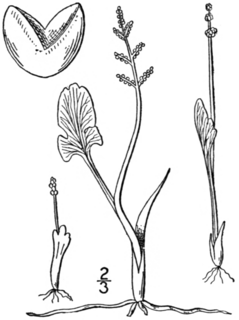
Botrychium simplex, the little grapefern, is a species of fern in the family Ophioglossaceae that is native to North America and Greenland. It is a perennial.
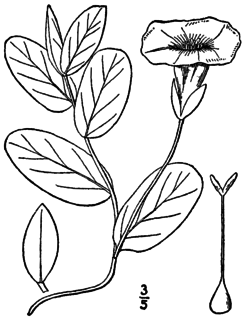
Calystegia spithamaea, which common names include: low false bindweed, low bindweed, erect bindweed, and upright bindweed, is a plant.
Linum intercursum, common names sandplain flax and sandplain wild flax, is a perennial plant native to the United States.

Lyonia mariana, the Piedmont staggerbush and staggerbush, is a perennial shrub that is native to the United States.

Ludwigia polycarpa, common names many-fruited false-loosestrife and false loosestrife seedbox, is a plant found in North America. It is listed as a special concern and believed extirpated in Connecticut, and as endangered in Massachusetts, Pennsylvania and Vermont.
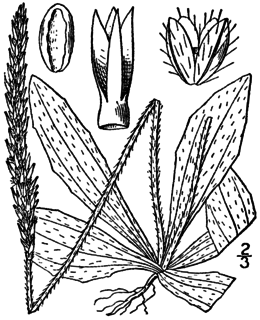
Plantago virginica, common names hoary plantain and Virginia plantain, is a plant found in North America. It is listed as a special concern in Connecticut. The Kiowa use it to make garlands or wreaths for old men to wear around their heads during ceremonial dances as a symbol of health.
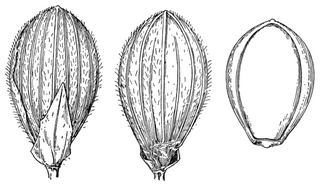
Dichanthelium xanthophysum, formerly known as Panicum xanthophysum, common names slender rosette grass, panic grass and slender panic-grass, is a plant found in North America. It is listed as a special concern and believed extirpated in Connecticut. It is listed as endangered in New Jersey and Pennsylvania.

Potamogeton confervoides, common names pondweed, alga-like pondweed, algae-like pondweed, and Tuckerman's pondweed is a species of plant found in North America. It is listed as endangered in Connecticut, as a special concern in Maine, as threatened in Massachusetts, New York (state), Pennsylvania, and Wisconsin. It is listed as historical in Rhode Island.

Panicum verrucosum, common name warty panicgrass, is a plant in North America. It is listed as a special concern and believed extirpated in Connecticut. It is listed as threatened in Indiana and Michigan, and as endangered in Ohio.

Piptatherum pungens, also called Oryzopsis pungens, commonly called slender mountain-ricegrass, ricegrass, northern ricegrass, or slender mountain-rice, is a plant found in North America. It is listed as endangered in Connecticut, Iowa, New Jersey, and Pennsylvania. It is listed as extirpated in Indiana, as a special concern in Rhode Island, and as threatened in Vermont.
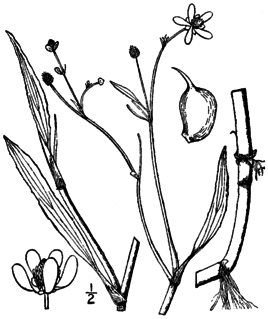
Ranunculus ambigens, common names water-plantain spearwort, water plantain, and spearwort, is a plant found in North America. It is listed as endangered in Connecticut, and New Hampshire, as endangered and extirpated in Maryland, as a special concern in Kentucky, as possibly extirpated in Maine, as threatened in Michigan, and as a special concern in Rhode Island.

Potamogeton hillii, common name Hill's pondweed, is a species of plant found in North America. It is listed as endangered in Connecticut, Ohio, and Pennsylvania. It is listed as a special concern in Massachusetts and as threatened in Michigan and New York (state).

Dichanthelium sphaerocarpon, also called Panicum polyanthes, common name round-seed panic grass, is a plant found in North America. It is listed as endangered in Michigan. Dichanthelium sphaerocarpon var. isophyllum is listed as a special concern and believed extirpated in Connecticut.

















